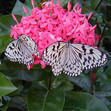
Erica's Original Notes
One of the many miracles of Nature, these 'flying flowers' enchant us every summer for only a few short weeks, especially if the weather is bad. However, they lead a complicated life style before they emerge to delight us - from egg to caterpillar and cocoon or chrysalis - going into the closet in work clothes to emerge wearing their best party dress.
Like all insects, the lepidoptera body has three parts:
a) The head with antennae, which act like fingers to 'feel' objects and may even detect sounds. They pick up odours too faint for our noses. Some moths can detect smells five miles away. They have compound eyes with hundreds of units, receiving a picture like a mosaic of dots, much like a newspaper photo. They probably see moving objects well and have two tiny single eyes just above the others for close-up viewing. Their mouth consists of a long slender coiled tube under the head in place of jaws, which they use much like a soda straw.
b) The thorax.
c) The abdomen, which carries four wings with scales, hence the scientific name lepidoptera for these insects, meaning scaly. These scales are much like shingles on a roof, in a great variety of shapes, giving strength and protection; they are really hairs that have developed into flattened shapes. The colour is due to fine lines, each catching and breaking up light (molecular colour, see Colour and Vision section). The six legs have feet that sometimes have taste buds, so that they can sample food as they alight!
Difference between moths and butterflies: The antennae in moths are thick or feathery; for butterflies they have a knob-like end. The bodies of moths are thicker and fuzzier, and their wing scales have rugged edges. At rest, the wings lie flat, while those of butterflies at rest are folded.
Eggs: Life starts out in an egg, sometimes the female is so loaded she can hardly fly. On hatching, the first meal is their own shell; they are now larvae or caterpillars and will not stop eating to draw breath! Known as an eating machine, with efficient jaws in front and an expanding body behind, they are continually moulting their outer jacket as it gets too tight; the new one is soft and stretches for the first few hours; this process may be repeated four to five times during this cycle. They breathe by spiracles, holes along their sides which lead to tiny tubes (air pipes) carrying fresh air and getting rid of waste. They have what are known as 'prolegs' in the midline: one anal, four abdominal, and three thoracic.
One well-known local monster is the tent caterpillar of which we have cyclical infestations; they make a silk nest for the campers to rest in each night at the end of a long day of chewing up the vegetation, hitting the silk trail each day out to 'work' the leaves! Exhausted after all this chewing, the larvae drop to the ground in order to start their next phase as Pupae. Before the last moult, the larva humps its back, pulls in its legs, and when the skin splits for the final time, a strange, blind, legless creature emerges, the pupa, looking like a mummy because the outline of new legs to be, wing pads and mouth are visible. It is now helpless and may suffocate if dust covers its spiracles. Then the excitement begins: moth caterpillars usually make themselves a cocoon, of which there are many varieties, but all serve to protect. The butterflies make a chrysalis, the pupa skin hardens and is attached by a thread of silk to some object.
A great recycling of tissues now takes place within, the many muscles and organs no longer needed in the adult are broken down, supplying, together with fat, the energy for new growth. The waste tissues are acted upon by phagocytes (scavengers) in the blood. The time for all this to take place varies from a few days (cabbage butterflies) to many months. Finally, in order to re-emerge in all their finery, there is a release mechanism, maybe a back ridge with a cutting edge, jaws that act like scissors, or a substance which dissolves the silk.
[Hyperlinks added 2013]
Useful Links:
Butterflies and Moths of BC
Banner Image by Couleur from Pixabay